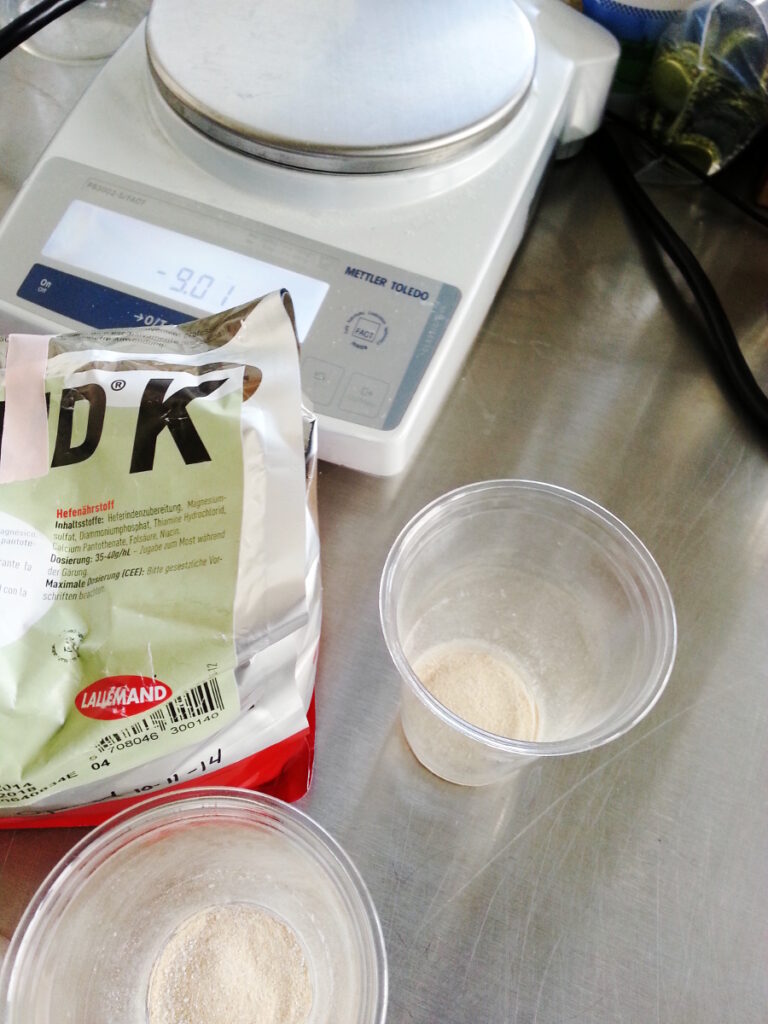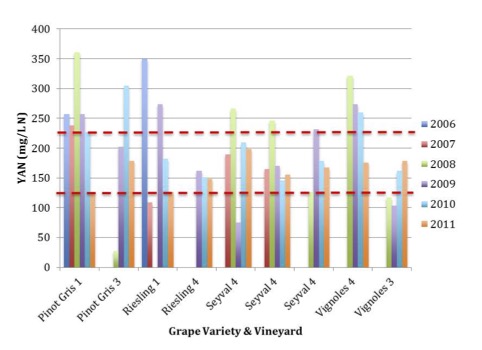As many winemakers have already jumped into harvest, I wanted to highlight just how important nutrient supplementation can be during primary fermentation!
But, wait! Are you confused about what YAN is? Have no fear! You can jump over to my FREE primer on yeast available/assimilable nitrogen (YAN), Fermentation Nutrition: What to Know and Why to Know It.
If you’re already “in the know” about YAN, here are 3 common facts I often hear many winemakers getting confused about when it comes to wine nutrition.
1. A wine can get hydrogen sulfide in low AND high YAN fermentations.

Photo by: Denise M. Gardner
Did you know that hydrogen sulfide, that stinky hard-boiled egg aroma, can develop in fermentations with either low or high YAN?
As discussed in the primer, above, fermentations that start in low YAN or high YAN levels can often result in hydrogen sulfide development. This is because both situations can lead to yeast stress. Hydrogen sulfide development is often developed as part of a yeast stress response.
Therefore, winemakers should optimize yeast nutrition strategies to both the starting YAN and chosen yeast strain.
For example, in a low YAN fermentation, selecting a low-nitrogen requiring yeast strain can help minimize the amount of nitrogen supplementation a winemaker needs to make during primary fermentation.
The opposite is true for a high YAN fermentation. In a high YAN fermentation, selecting a high-nitrogen requiring yeast strain can help reduce the overall nitrogen concentration in the fermenting wine. In this case, the yeast strain can more easily obtain the nitrogen requirement it needs for a healthy, successful fermentation.
I recommend having both types of a yeast strains available at the start of harvest so that they are there, and ready to go on a moment’s notice.
2. There is no way to predict YAN… and its value is not the grower’s fault.
Years of research has shown winemakers that a must’s starting nitrogen concentration varies from year-to-year. Thus far, no trends have been discovered between vineyard management techniques and resulting nitrogen concentrations held in the grapes.
In 2012, I analyzed nitrogen data collected by a regional winery who had been storing YAN data they collected for over 6 years. The data was unique in that it tracked YAN concentrations from single varieties planted in single vineyard blocks over a large stretch of time. Not surprisingly, the data confirmed variation in nitrogen concentrations prior to fermentation on an annual basis (Figure 1).

While the primary source of nitrogen comes from the fruit itself, YAN values in any one variety can change annually. At two research vineyard sites I used to work with, there were about 30 wine grape varieties planted within an acre of land. Even within that one acre, YAN values ranged from low to high and everything in between.
What does this mean for winemakers?
With the current scientific understanding of YAN, it cannot be predicted or, even, estimated. It’s something winemakers must make time to measure if they are going to treat their fermentations appropriately and regarding starting nitrogen concentrations.
3. Wineries have options for measuring YAN.
Many wineries are hesitant to measure YAN because it requires some planning, time, and financial resources in order to get the nitrogen measured in an appropriate amount of time. Not only is the timing important in terms of when a sample is collected and analyzed, but also having adequate analytical equipment is a necessity.
I recommend sampling white/rosé juices while they are settling to measure YAN. For reds, I recommend collecting a must sample, and provide about 30 minutes to 1-hour of contact time with the grapes. The contact time should be consistent from sample-to-sample. After the contact time has been reached, siphon off the skins and measure YAN on the juice.
In the primer, above, I’ve provided details regarding equipment needs when using a spectrophotometer. Since I wrote that primer, there are additional options wineries can look into when it comes to measuring YAN:
- Send out juice samples with overnight shipping: In the primer, above, there are details for how to ship samples to a lab, like ETS, for a YAN analysis.
- Mini-Specs: For about $3,000 – $3,500, wineries can purchase a mini-spectrophotometer system that can be used for several different enzymatic assays, including YAN. While this cost may seem high, compared to a normal spectrophotometer, it’s a fraction of the cost. The Unitech Enolyzer and Megazyme MegaQuant are two units I know a few wineries have invested in and find useful for measuring YAN, as well as several other wine analytes.
- Vinmetrica: The Vinmetrica SC-200 and SC-300 units can analyze YAN with a Vinmetrica-specific YAN Test Kit. The Test Kit uses the Formol Titration method to read YAN. I should note two things: (1) I am not a proponent of the Formol Titration because it requires the disposal of formaldehyde, which can be difficult to do safely for many winery operations, and (2) I have no experience using this unit for YAN purposes, but it is an option that I have seen wineries investigate in order to start measuring YAN.
Further resources for making appropriate nitrogen adjustments during fermentation
It’s important to note that nutrient addition strategies are heavily researched, and recommendations frequently change. I recommend keeping current with these changes. Practicing nutrient strategies from recommendations made in the 1980’s could lead to fermentation problems, especially stuck fermentations or hydrogen sulfide development.
Luckily, finding current YAN strategies is easy! Enological product suppliers (e.g., Lallemand, Enartis, Laffort, etc.) usually update their nutrient addition strategies, specific for their products, annually. You can review these updates by downloading or receiving their winemaking handbooks.
If you struggle to understand how YAN is calculated, and how nutrient additions contribute to the YAN content, you can download the DGW free YAN Calculation Worksheet. This worksheet will teach you to better understand how DAP, hydration nutrient, and complex nutrient additions contribute to YAN.
Finally, if developing a better YAN strategy is of interest, both DGW Insider and DGW Elite Memberships provide valuable resources associated with YAN.
- Production Guide: Fermentation Nutrition Strategies
- Winemaking Lesson: What is YAN? (with printable notes)
- Winemaking Lesson: Measuring YAN (with printable notes)
- Winemaking Lesson: Adjusting YAN during Fermentation (with printable notes)
In addition to access to these resources listed above, DGW Elite Members can attend twice-monthly Q&A sessions with Denise and other DGW Clients/Members. In those sessions, we can review details pertaining to all of your YAN questions! More information on DGW Insider and Elite Memberships is available, here.
